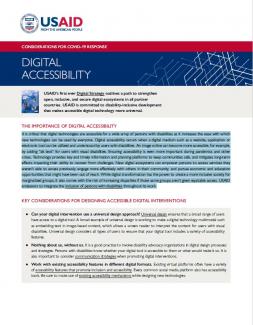THE IMPORTANCE OF DIGITAL ACCESSIBILITY
It is critical that digital technologies are accessible for a wide array of persons with disabilities as it increases the ease with which new technologies can be used by everyone. Digital accessibility occurs when a digital medium such as a website, application or electronic tool can be utilized and understood by users with disabilities. An image online can become more accessible, for example, by adding “alt text” for users with visual disabilities. Ensuring accessibility is even more important during pandemics and other crises.
Technology provides key and timely information and planning platforms to keep communities safe, and mitigates long-term effects impacting their ability to recover from challenges. New digital ecosystems can empower persons to access services they weren’t able to access previously, engage more effectively with others in their community, and pursue economic and education opportunities that might have been out of reach. While digital transformation has the power to create a more inclusive society for marginalized groups, it also comes with the risk of increasing disparities if those same groups aren’t given equitable access. USAID endeavors to integrate the inclusion of persons with disabilities throughout its work.

